Hinduism
For Lord Ganesha:
Twenty one day fast
Chelvatamby Maniccavasagar
This is an important fast observed by Hindus in Vinayagar Temple. In
fact, every Hindu temple has a sanctum dedicated to Lord Ganesha. Hindus
bow their heads in reverence and make their first offering to Lord
Ganesha in all ritualistic worship. Be it pilgrimage, wedding, yagam or
house warming, Lord Ganesha is the first deity to be worshipped at the
beginning of any ceremony.
|
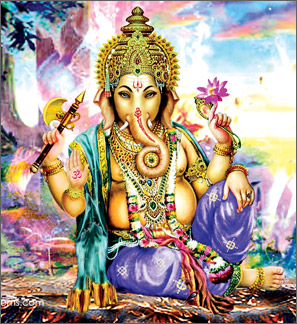
The broken tusk signifies the breaking away from ignorance |
Vinayaga, Ganapathy, Vigneswara and Pillaiyar are some of the common
appellations given to Lord Ganesha, the God with the elephant head. The
Supreme Brahman – Lord of the Universe – is beyond sex. He is both man
and animal. Lord Ganesha has a form which signifies this fact, with the
limbs of a man and the face of an animal.
Lord Ganesha is elephant faced and it is proverbially the most
intelligent among mammals. The head consequently represent Divine Gnaana.
Moreover, elephant is a vegetarian and this indicates pure Sathuic
nature. The broad head also signifies that God is broadminded, tolerant
and sympathetic to all activities.
The bulky body stands for the cosmos in its entirety. The huge
pot-belly signifies space containing all things and beings of the world.
The Lord Ganesha has a snake which indicates energy in all forms. The
idea contained in the concept is that all things have their allotted
place in the womb of nature and they are all supported by cosmic energy.
The trunk represents the sensitive reception of stimuli and
cognition. It also signifies the faculty of discrimination. Further, he
is single-tusked. The broken tusk signifies that he has broken away from
ignorance, which guides the path of God. The tusk which the Lord of
Wisdom deliberately broke while writing the great Epic Mahabharatha
which goes to explain that no sacrifice is too great for a noble cause
and the resourceful knows no impediment. The single tusk also denotes
single-mindedness in action. The other tusk indicates highest knowledge.
Lord Ganesha’s broad ears signify that he hears everything
communicated to him. They indicate omniscience. The three eyes of Lord
Ganesha represent the ‘moon’, the ‘sun’ and ‘fire’ which in turn
indicates the three phases of creation, sustenance and destruction. The
third eye is a symbol of intuitive knowledge.
He has four hands which signify super natural powers. In one he holds
a Paasa or ‘rein’ which represents the creative and sustaining faculty.
The paasa also indicates that Lord Ganesha uses this rein to attract
the minds of the devotees so as to direct them on the right path to
reach God.
In his left hand he holds an ‘Ankusa’ or the whip which denotes the
destructive phase of cosmos. This spear-like weapon also indicates that
Lord Ganesha uses it to destroy ignorance in his devotees. The third
hand holds a dish of Modhaka (a globular sweet meat).
This signifies that he distributes the consequence according to the
actions of the Jeevas. It also signifies that providing oneself with
food that is conducive to the robust growth of the body and mind. The
Modhaka also symbolizes the fullness of Brahman.
The fourth hand represents Abhaya. He gives protection to the
deluded, caught in the world of petty happiness and sorrow. He assures
liberation from the deception of the illusionary world and grants wishes
to those who deserve. Further, Lord Ganesh a uses his little mouse as
his vehicle. This shows that all beings high and low, big and small are
the vehicles of the Divinity enshrined in the hearts.
The mouse also personifies the evil qualities like anger, pride and
selfishness. Lord Ganesha riding on the mouse shows that he keeps the
evil passions always under check.
The adoration of Lord Ganesha in the Arts has been remarkably
universal and has very often cut across religions. His dominant
manifestations has been in warding off all evils. He even creates
obstacles that one prays to him to remove them. Lord Ganesha has been a
major deity since the seventh and eighth centuries in Thailand, Cambodia
and Vietnam. In Thailand Lord Ganesha is regarded as God of Success.
Furthermore, the worship of Lord Ganesha goes back almost five
thousand years. Indus Valley seals bear the imprint of the Elephant God.
With the spread of Buddhism, His worship spread as far as China, Japan,
Tibet, Nepal, Afghanistan and South East Asia. His popularity spread
even to Java, Bali and Borneo. In North India, Ganesha is conceived as
having Buddhi and Siddhi as His consorts.
In fact, the twenty one day fast observed by Hindus in Vinayagar
temples with devotions, removes all our obstacles and impediments. A
common form of worship of Lord Ganesha is rapping at the forehead with
knuckles and pulling earlobes with crossed hands. This act helps in the
purification of the Naadis. The smashing of coconuts at the steps of
Lord Ganesha shows that the hard nut of ego should be cracked and got
rid of before God and subsequently prostrated for complete surrender.
The camphor that is burnt in front of Lord Ganesha signifies that we
have to burn our illusion or ego with the fire of true knowledge and
leave no residue so that we may merge with God.
Indeed, we the people living in this Kali yuga hope and pray that
Lord Ganesha showers His universal love and compassion, so that we may
be bathed by His divine glory and spiritual splendour to overcome the
present agony and acquire spiritual attainments, peace and happiness.
Simplifying Hinduism
Poulami Mukherjee
In the process of drawing criticism from various quarters, the
essence of Hinduism has been lost. It has, in fact, assumed negative
overtones in the minds of the younger generation. In order to quell “the
misconceptions associated with Hinduism”, the monks of Kauai’s Hindu
Monastery at Kapaa (Hawaii) decided to spread the concepts of the
religion through the medium of a film. Named What is Hinduism: God, Soul
& World, the film is directed by Ajay Shetty and Anasuya Vaidya and is
based on the third chapter of the book What is Hinduism, written by the
monks of the monastery.
|
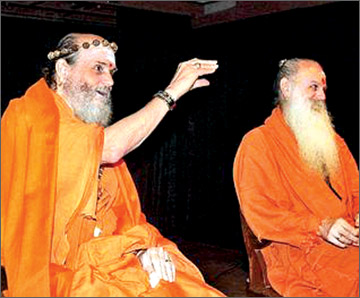
Concepts of Faith - A discussion on the film at Akshara
Theatre |
The 27-minute film was screened at Akshara Theatre in New Delhi
recently in the presence of Satguru Shri Bodhinath Vailanswamiji Maharaj
and Paramacharya Palaniswamiji of Kauai along with the film’s cast and
crew. To welcome the monks from Hawaii, the screening was preceded by
the chanting of verses from the Ishavasya Upanishad and an enactment of
a scene from Ramayana by a group of children.
With Bharatanatyam dancer Geeta Chandran as the narrator, the film
begins by posing questions of existence that are integral to Hinduism.
It touches upon the concepts of maya, moksha, mukti and the existence
of God. It further explains the four different sects within the religion
– Saivism, Shaktism, Vaishnavism and Smritism.
The highlight of the film, however, is the dramatised ‘meeting of
minds’ between Lalleshwari (Jalabala Vaidya), Kabir (Gopal Sharman),
Mirabai (Nisa Shetty) and Ramprasad Sen (Jayadevan Nair), who discuss
the different interpretations of liberation. Strung artfully with
voice-overs, graphics, chanting of slokas, shots of Hindu temples and
narration, the film is successful in simplifying the complex ideas of
Hinduism.
Discussing the film post- screening, Satguru Shri Bodhinath said,
“The film shows the diversity of the religion as it allows us to choose
that part which highlights our needs.”
Paramacharya, citing the reason behind the film, said, “The idea
evolved from YouTube. I realised that we needed to speak to the youth
about Hinduism through a friendly medium as most would not read the
book.” The monk, who is the Editor-in- Chief of the magazine “Hinduism
Today”, also praised the directors for “giving a voice to the book.”
Both Ajay and Anasuya have been asked to work on the remaining of the
series as well. Narrating their experience, the directors said, “It was
quite scary to interpret the concepts and thoughts of the book and make
a film out of it. It was a challenge to retain the essence of the book
within those 27 minutes.”
Talking about the genre of the film, they said, “It is a blend of
different genres as it caters to all kinds of people. So there are
elements of documentary, drama, one-to-one narrative as well as
infotainment.”
The film, sponsored by an NRI, would be screened both in India and
abroad “to spread the true essence of Hinduism.”
The Hindu
Thiruvilayadal puranam:
Sincerity pays
Thilaka V Wijayaratnam
After the demise of Varaguna Pandyan, his son Rasarasa Pandyan
ascended the throne. His wife was a musician. So was the court singer’s
(Paanam) wife. The queen and Paanan’s wife were rivals. The queen wanted
to humble Paanan’s wife. She coaxed her husband, the king to help her in
this matter.
|

Paanan’s wife went to the temple and prayed |
The Paandya king got down a female singer from Eelam (country in the
east – Ceylon) to compete with Paanan’s wife.
The king called Paanan’s wife and asked if she could compete with the
singer from Eelam. She said, “with the Grace of God Somasunarar I can.”
So a competition was arranged before a large audience.
The audience appreciated the Paanam’s wife’s performance not knowing
the king’s intention when the king praised the woman from Eelam, the
audience took the hint and praised her. The king ordered all to come the
next day for the judgement.
Paanan’s wife went to the temple and prayed. “O God, the king is
biased. The audience also supported him. Only you can give the correct
verdict.” Then she heard an oracle, “Do not worry. We will judge
correctly.”
The next day too the king decided in favour of the singer from Eelam.
Then Paanan’s wife said, “O king you are biased. The audience also
followed you. Let us have this competition in the temple for God
Somasundarar. If she wins, according to your condition. I will become
her slave.”
The king agreed. The next day they all gathered in the Mandapa
opposite the sanctum sanctorum of the temple. God Somasundarar in the
guise of a Vidvan – an exponent of music, sat among the audience. The
competition began. The singer from Eelam was so sure she would win, that
she behaved arrogantly even when she sang. But there was no reaction
from the king or the audience for her performance. Then the Paanan’s
wife, humble and unassuming sat with the Veena and song. Her song was in
praise of God Somasundarar, and she sang it with piety.
The audience applauded her and even the king praised her singing. It
was decided that Paanan’s wife was the better singer.
Just then the Vidvan – stood up and exclaiming, “This is wonderful,
wonderful”, disappeared. The king and the people realized it was no
other than God Somasundarar who was instrumental in their giving the
correct verdict. They praised Paanan’s wife for her devotion, saying,
God will be with the sincere. “Sincerity does pay,” they commented.
Swamy Iyappan CD release
The well-known Tamil devotional singer Chidambaram Thiyagarajah will
release his new CD containing Tamil devotional songs on December 12,
2010 at 4.00 p.m., Iyangaran Hall, Kotahena. The theme of this CD is My
Voice is a blessing of Iyappan.

Swamy Iyappan is the power Hindu lord whose temple is situated at the
height of Sabavimalai.
A special feature of the ceremony is the distribution of school
stationery and equipment to 150 needy students.
A special pooja will be conducted by Deshabandu Sivasri Bala
Ravishankara Sivachchari.
The CD with Iyappan devotional songs will also contain two songs
about Mayurpathy Amman too. All the songs were sung by Chidambaram
Thiyagarajah child singers Akshiya Thiyaga Rajah and Kawsalya
Thiyagarajah had also composed music to the tunes of Thiyagarajah,
lyrics by K Selvarajah and S Mohanras. The main singer Chidambaram
Thiyagarajah is a well-known businessman and social worker.
He already released 12 CDs and several cassettes which contain more
then 85 songs praising the fame of Swamy Iyappan.
Thiyarajah’s songs can be heard in the Iyappan temple in Sabavimalai
also. Next to the songs of world famous singer K J Jesudas only
Chidambaram’s songs can be heard at Iyappan temple during great Iyappan
season.
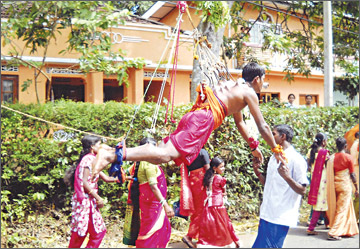 |
The annual Thir festival of Sri Muttu
Mari Amman Kovil in Mahawela. Here a young devotee pays
tribute to God Siva by fixing the hooks to the body. |
 |
A special Deepavali function was held
at Police ground, Bambalapitiya organized by the Sri Lanka
Police Buddhist and other Religious Society headed by the
Inspector General of Police Dr Mahinda Balasuriya. Livestock
and Rural Community Development Minister Arumugam Thondaman
was the Guest of Honour. Senior Superintendent of Police K
Arasaratnam being welcomed at the function. |
 |
The devotees who have been selected
for Sabarimalai Holly pilgrimage tour attended the
garlanding ceremony on November 11, 2010. The ceremony took
place under the patronage of the President Co-ordinator for
Hindu Religious Affairs and Chief Priest Iyappa Seva
Peedathipathy Sivashri Bala Ravi Shankara Sivachariyar at
the Arulmigu Sri Gnana Bairawar Swamy Hindu Kovil Grandpass,
Colombo 14. Pictures by A Maduraveeran |
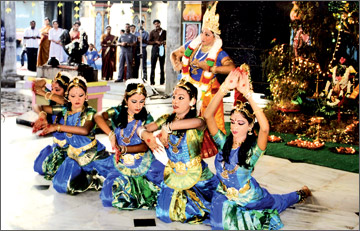 |
Pupils of the Natya Kala Mandir
(Centre for Visual and Performing Arts) presented a
religious dance item titled Nandana Mohana Krishna at the
Deepavali celebration held at the Sri Venkateswarar Maha
Vishnu Kovil, Modera, Colombo 15. The event was organized by
the Vasantham Tamil television channel, affiliated to the
Independent Television Network (ITN). |
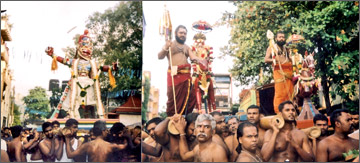 |
The annual Soorasamharam celebration
took place last week at Hindu Kovils, islandwide to mark the
Kanthasasti Viratha Puja. Here, a Soorasamharam event,
organized by the Sri Sivasumbramaniam Kovil, Jeyanthi Nagar,
Ginthupitiya, Colombo 13. |
|



